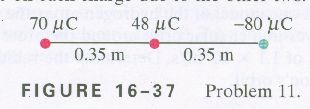Difference between revisions of "Giancoli Physics (5th ed) Chapter 16"
From TuHSPhysicsWiki
(→1.How many electrons make up a charge of -30.0 mC?) |
(→3.) |
||
| Line 11: | Line 11: | ||
[[#top | Table of Contents]] | [[#top | Table of Contents]] | ||
---- | ---- | ||
| − | ===3.=== | + | ===3. Two charged balls are 20.0 cm they are moved, and the force on each of them is found to have tripled. How far apart are they now?=== |
| + | :Solving this problem is nice, because in this case while we use the formula F = kq1q2/r2 we can ignore both charges and the variables F and k. Since the resulting force is tripled, we know that the radius of the new situation will be 1/3 of the original value of r2. To start this problem, we need to set two equations equal to one another. This works because but cutting the original value of r2 by 1/3, the two equations will be equal and we can then solve for r in the new situation. | ||
| + | ::F = kq1q2/r2 | ||
| + | ::kq1q2/r2 = kq1q2/r2 | ||
| + | :Remove unnecessary variables and set equations equal by multiplying r2 by 1/3 in equation 1. | ||
| + | ::1 / ((1/3)* 202) = 1 / r2 | ||
| + | ::(1/3) * (202) = r2 | ||
| + | :r = .012 m or 11.5 cm | ||
| + | |||
[[#top | Table of Contents]] | [[#top | Table of Contents]] | ||
---- | ---- | ||
| + | |||
===4.=== | ===4.=== | ||
[[#top | Table of Contents]] | [[#top | Table of Contents]] | ||
Revision as of 15:25, 5 September 2007
Contents
- 1 Problems
- 1.1 1.How many electrons make up a charge of -30.0 mC?
- 1.2 2.
- 1.3 3. Two charged balls are 20.0 cm they are moved, and the force on each of them is found to have tripled. How far apart are they now?
- 1.4 4.
- 1.5 5.
- 1.6 6.
- 1.7 7.
- 1.8 8.
- 1.9 9.
- 1.10 10.
- 1.11 11. Particles of charge +70, +48, and +80 mC are placed in a line (fig. 16-37) the center one is 0.35m from each of the others. Calculate the net force on each charge due to the other two.
- 1.12 12.
- 1.13 13.
- 1.14 14.
- 1.15 15.
- 1.16 16.
- 1.17 17.
- 1.18 18.
- 1.19 19.
- 1.20 20.
- 1.21 21.
- 1.22 22.
- 1.23 23.
- 1.24 24.
- 1.25 25.
- 1.26 26.
- 1.27 27.
- 1.28 28.
- 1.29 29.
- 1.30 30.
- 1.31 31.
- 1.32 32.
- 1.33 33.
- 1.34 34.
- 1.35 35.
- 1.36 36.
- 1.37 37.
- 1.38 38.
- 1.39 39.
- 1.40 40.
- 1.41 41.
- 1.42 42.
- 1.43 43.
- 1.44 44.
- 1.45 45.
- 1.46 46.
- 1.47 47.
- 1.48 48.
- 1.49 49.
- 1.50 50.
- 1.51 51.
- 1.52 52.
- 1.53 53.
- 1.54 54.
- 1.55 55.
- 1.56 56.
Problems
1.How many electrons make up a charge of -30.0 mC?
- Since electrons have charges of –1.6E-19 C all we need to do is divide the given charge by the electron charge to give us the number of electrons. Also, be careful with the whole mili-coulombs thing.
- -30 mC / 1.602E-19 C = 1.88 E14 electrons
2.
3. Two charged balls are 20.0 cm they are moved, and the force on each of them is found to have tripled. How far apart are they now?
- Solving this problem is nice, because in this case while we use the formula F = kq1q2/r2 we can ignore both charges and the variables F and k. Since the resulting force is tripled, we know that the radius of the new situation will be 1/3 of the original value of r2. To start this problem, we need to set two equations equal to one another. This works because but cutting the original value of r2 by 1/3, the two equations will be equal and we can then solve for r in the new situation.
- F = kq1q2/r2
- kq1q2/r2 = kq1q2/r2
- Remove unnecessary variables and set equations equal by multiplying r2 by 1/3 in equation 1.
- 1 / ((1/3)* 202) = 1 / r2
- (1/3) * (202) = r2
- r = .012 m or 11.5 cm
